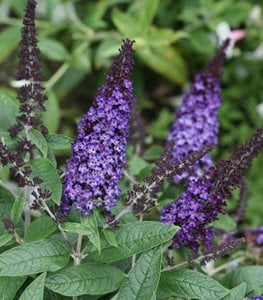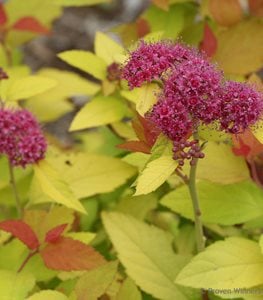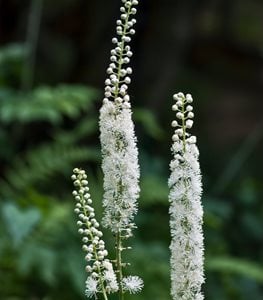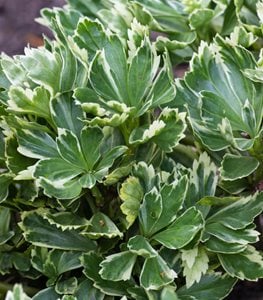Deer Feed That Will Grow Without Year Round Water That Cows Wont Eat

Deer love to graze on many types of groundcovers, especially when new, tender growth emerges in the spring.
The ornamental plants and shrubs in your garden should be a feast for the eyes, not a banquet for the local deer population. Although it's impossible to make a backyard completely deer-proof, you can fill it with plants deer hate and minimize deer damage. For a natural look, this deer-resistant wildflower mix is great, otherwise check out the suggestions below.
"You can still have a lush, thriving garden by making smart choices. Many stunning plants are unpalatable to deer because of their poisonous compounds, fuzzy or aromatic leaves, and tough, spiny, or bristly textures," says Ruth Rogers Clausen, author of 50 Beautiful Deer-Resistant Plants. We've included some of Clausen's smart choices, along with a few top picks of our own, in this list of deer-resistant plants.
ON THIS PAGE:
- DEER-RESISTANT FLOWERS (ANNUALS)
- DEER-RESISTANT SHRUBS
- DEER-RESISTANT PERENNIALS
- DEER-RESISTANT GROUNDCOVERS
- PLANTS TO AVOID
- DEER-PROOFING TIPS
- ONLINE LEARNING
DEER-RESISTANT FLOWERS (ANNUALS)

Artist® Blue floss flower. Photo by: Proven Winners.
FLOSS FLOWER
Clusters of lavender-blue flowers and rough-textured foliage keep deer at bay. Available in shades of blue, pink, purple, and white. For a floss flower that doesn't require deadheading and is better suited for hot climates, try Artist® Blue (pictured).
Zones: 10-11, grown as an annual elsewhere
Exposure: Full sun to partial shade
Bloom time: Late spring through fall
Height/spread: 4 to 36 inches tall, 6 to 18 inches wide
Learn more about growing floss flower.

Tagetes tenufolia 'Lemon Gem'. Photo by: RM Floral / Alamy Stock Photo.
SIGNET MARIGOLD
All varieties of marigolds are a turnoff for deer because of their strong, pungent scent. However, signet marigolds (pictured) have a lighter citrusy smell and flavor, making them popular for culinary use.
Zones: 9-10, grown as an annual elsewhere
Exposure: Full sun
Bloom time: Late spring until frost
Height/spread: Varies widely, 6 inches to 4 feet tall, 6 inches to 2 feet wide
Learn more about growing marigolds.

Superbena® Violet Ice. Photo by: Proven Winners.
VERBENA
Verbenas bloom from spring until frost if trimmed back in midsummer. The small flower clusters come in a wide range of colors, including white, pink, blue, lavender, purple, dark red, yellow and bicolor.
Zones: 8-11, grown as an annual elsewhere
Exposure: Full sun
Bloom time: May through October
Height/spread: Varies, from low-growing to upright.
Learn more about growing verbena.
Buy verbena plants from Proven Winners

Rocket mix snapdragon. Photo courtesy Kleft Seed.
SNAPDRAGON
Dramatic spikes of flowers make snapdragons a stunning addition to a deer-resistant garden. Snapdragons bloom most profusely in the cooler weather of spring and fall, and come in a variety of cultivars.
Zones: 9-10, grown as an annual elsewhere
Exposure: Full sun
Bloom time: Mid-spring to frost
Height/spread: 6 to 30 inches tall, 10 to 18 inches wide
DEER-RESISTANT SHRUBS

North Star® boxwood. Photo by: Proven Winners.
BOXWOOD
Among the most versatile evergreens for a deer-resistant garden. They come in numerous shapes and sizes and take well to pruning. Deer seem to shun them because of their strong scent.
Zones: 4-8
Exposure: Partial or dappled shade, protect from harsh mid-day sun
Height/Spread: Varies greatly, from 1 to 20 feet tall, 2 to 8 feet wide
Learn more about growing boxwood plants.
Buy from Proven Winners

Happy Face® potentilla. Photo by Proven Winners.
CINQUEFOIL
One of the best flowering shrubs for season-long color. Deer tend to find the finely textured blue-green foliage unappealing. Popular cultivars include Happy Face® (pictured).
Zones: 2-8
Exposure: Full sun to partial shade
Bloom time: June through September
Height/Spread: Varies, from 3 inches to 4 feet tall, 6 inches to 5 feet wide
Learn more about growing cinquefoil plants.
Buy from Proven Winners

Pugster Blue® butterfly bush. Photo by: Proven Winners.
BUTTERFLY BUSH
Attract bees and butterflies while you fend off deer. Flower colors are typically deep purple, pink, or white, although some hybrids have orange and gold blooms. For smaller gardens, try Pugster.
Zones: 5-9
Exposure: Full sun
Bloom Time: Summer until frost
Height/Spread: Varies, 18 inches to 7 feet tall, 18 inches to 5 feet wide
Learn more about growing butterfly bush.
Buy from Proven Winners

Double Play® Candy Corn® spirea. Photo by Proven Winners.
SPIREA
It's a bit of a mystery why deer avoid spirea. A wide array of sizes are available. An interesting choice is Double Play® Candy Corn® (pictured), with foliage that emerges bright red and matures to yellow.
Zones: 3-8
Exposure: Full sun
Bloom time: There are spring- and summer-blooming varieties
Height/Spread: 1 to 8 feet tall, up to 6 feet wide
Note: Japanese spirea (Spiraea japonica) is invasive in parts of the U.S. and Canada; see where.
Learn more about growing spirea plants.
Buy from Proven Winners

Gin Fizz™ juniper. Photo by Proven Winners.
JUNIPER
Junipers have many different uses: groundcovers, accent plants, topiaries, and privacy screens. They repel deer because of the volatile oils in their needles, they also are drought tolerant and have few pest problems.
Zones: 3-7
Exposure: Full sun
Height/Spread: Varies greatly, 6 inches to over 100 feet tall, 1 to 25 feet wide
Learn more about growing junipers.
Buy from Proven Winners
DEER-RESISTANT PERENNIALS

'Denim 'n Lace' Russian sage. Photo by: Proven Winners.
RUSSIAN SAGE
The finely-cut silvery foliage makes it an eye-catching filler plant in a sunny perennial garden. Tiny flowers bloom on tall stalks, producing lovely plumes of color. The flowers will often last well into October.
Zones: 5-9
Exposure: Full sun
Bloom Time: Early summer to fall
Height/Spread: Varies, 2 to 4 feet tall & wide
Learn more about growing Russian sage.
Buy Russian sage plants from Proven Winners

'Pardon My Cerise' bee balm. Photo by Proven Winners.
BEE BALM
One of the best plants for attracting and supporting pollinators; however, deer tend to leave it alone because of its pungent fragrance.
Zones: 3-9
Exposure: Full sun to partial shade
Height/Spread: Varies, 1 to 4 feet tall, 8 inches to 3 feet wide
Learn more about growing bee balm.
Buy bee balm plants from Proven Winners

'Stuart Boothman' bleeding heart. Photo by Ball Horticultural Company.
FRINGED BLEEDING HEART
One of the few native woodland plants that deer don't go for. Although a bit less showy than the common bleeding heart, the heart-shaped flowers range in color from white to various shades of pink.
Zones: 3-9
Exposure: Full sun
Bloom Time: Late spring to early fall
Height/Spread: 1 to 3 feet tall & wide
Learn more about growing bleeding heart.

MONKSHOOD
Despite monkshood's notoriety as a poisonous plant, it has a captivating beauty and provides a welcome display of late-season color.
Zones: 3-8
Exposure: Full sun to partial shade
Bloom Time: Late summer through fall
Height/Spread: 2 to 4 feet tall, 1 to 2 feet wide

Photo by PaylessImages / 123RF.
PEONY
Prized for their large, fragrant blooms, peonies have many attributes beyond their breathtaking beauty. They are tough, reliable, long-lived, and virtually pest-proof-including deer.
Zones: 2-8
Exposure: Full sun to partial shade, depending on variety
Bloom Time: Late spring to early summer, depending on variety
Height/Spread: Varies, 1 to 3 feet tall & wide for shrub varieties; 4 to 7 feet tall and up to 5 feet wide for tree peonies.
Learn more about growing peonies.

BLACK COHOSH
Also called black snakeroot and bugbane, this plant's bottlebrush-shaped flower spikes add drama and interest to a shade or woodland garden and have an unpleasant odor and bitter taste that repel deer.
Zones: 4-9
Exposure: Partial to full shade
Bloom Time: Summer
Height/Spread: 4 to 6 feet tall, 2 to 4 feet wide

'Silver Dust' dusty miller. Photo by Tim Gainey / Alamy Stock Photo.
DUSTY MILLER
Grown primarily for its attractive silvery-gray foliage, dusty miller has a felt-like coating that deer find unappetizing.
Zones: 7-10
Exposure: Full sun to partial shade
Height/Spread: Up to 2 feet tall & wide

Lamb's Ear. Photo by Julia Senkevich / Shutterstock.
LAMB'S EAR
The grey-green foliage has a velvety soft, wooly texture which deer don't like. This easy-care plant blooms in summer with spikes of pink to purple flowers.
Zones: 4-8
Exposure: Full sun to partial shade
Height/Spread: 6 to 12 inches tall, 1 to 4 feet wide
DEER-RESISTANT GROUNDCOVERS

Pachysandra terminalis 'Variegata'. Photo by John Richmond / Alamy Stock Photo.
JAPANESE PACHYSANDRA
Primarily grown for its glossy green foliage, which spreads quickly; an added attraction are spikes of tiny white blooms. 'Variegata' (pictured) has leaves with creamy white edges.
Zones: 4-9
Exposure: Partial to full shade
Bloom time: Early spring
Height/Spread: 3 to 4 inches tall, spreads 7 to 8 inches

Athyrium niponicum var. pictum. Photo by Ball Horticultural Company.
JAPANESE PAINTED FERN
Deer ignore most ferns, including this low-growing variety with silver-gray fronds painted with strokes of green and mauve. Like other ferns, it spreads freely by creeping rhizomes, but not aggressively.
Zones: 4-9
Exposure: Partial to full shade
Height/Spread: 1 to 3 feet tall, 1 to 2 feet wide

Photo by Ball Horticultural Company.
LADY'S MANTLE
Clusters of tiny chartreuse flowers held on long stems make lady's mantle a garden favorite. The broad scallop-edged leaves are covered with soft hairs that deer find objectionable.
Zones: 3-9
Exposure: Full sun to partial shade
Bloom time: Late spring to early summer
Height/Spread: 1 to 2 feet tall & wide

LILY OF THE VALLEY
Dainty bell-shaped flowers perfume the air with a heavenly fragrance in early spring. Bright red berries form after flowering, and the lance-shaped leaves last all summer, serving as an attractive groundcover.
Zones: 2-7
Exposure: Partial to full shade
Bloom time: Early spring
Height: 6 to 18 inches tall
Learn more about growing lily of the valley.

Carex morrowii 'Ice Dance'. Photo by: Ball Horticultural Company.
JAPANESE SEDGE
This clump-forming grasslike plant makes an excellent groundcover for moist, shady areas. Cultivars with variegated green and white foliage are particularly stunning, providing a luminous glow.
Zones: 5-9
Exposure: Partial to full shade
Height: 12 to 24 inches tall
PLANTS TO AVOID
| ANNUALS | Coleus, impatiens, pansies and violas, petunias, and zonal geraniums (Pelargonium) |
| SHRUBS | American arborvitae, evergreen rhododendrons and azaleas, hybrid tea rose, yew |
| PERENNIALS | Daylily, goat's beard, cranesbill geranium, hosta, Solomon's seal |
| GROUNDCOVERS | English ivy, lilyturf, wintercreeper |
DEER-PROOFING TIPS
Deer-Resistant Foliage - The 3 Fs
See more deer-resistant plants
- Startle them. Deer are often frightened away by loud noises and sudden movement. Keep them on edge by hanging wind chimes from the branches of trees and shrubs or by placing wind spinners throughout your garden. If that doesn't work, try startling them with a sudden spray of water by installing a motion-activated sprinkler.
- Use other plants to deter them. Interplant aromatic perennial herbs throughout your garden that have scents that deer hate, such as mint, thyme, French tarragon, lavender, chives, sage, and rosemary.
- Repel and fertilize. Deer love the tender new leaves and shoots of groundcovers when they first emerge in the spring. To eliminate the temptation, treat the area with a strong-smelling deer repellent or something that also doubles as a chemical-free fertilizer, such as blood meal or fish emulsion. "Be careful not to overfertilize, which will result in the soft, succulent vegetative growth that deer love. Just half the recommended dosage at a given time will leave the odor but not overstimulate the plants," advises Clausen.
- Plant higher. You don't have to avoid growing all the annuals that deer like to nibble on. Instead, put them in containers on a balcony or front porch or plant them in hanging baskets that are too high for deer to reach. You can also try a deer-resistant wildflower mix.
- Fence it in. If all else fails, surround your garden with tall deer fencing or other impenetrable barrier. Learn how to build your own "Critter-Resistant Vegetable Garden".

ONLINE LEARNING:
DESIGNING A DEER-RESISTANT GARDEN
With an emphasis on design, gardening expert Karen Chapman teaches you her tried-and-true methods for creating beautiful, deer-resistant garden areas. Her tips go well beyond a deer-resistant plant list, as she shows you multiple strategies, as well as how to combine them together to get more bang for your deer-resistant buck. Sign me up!
New book release from Karen Chapman, Deer Resistant Design: Fence-free Gardens That Thrive Despite the Deer - buy now on Amazon.
RELATED READING
Source: https://www.gardendesign.com/plants/deer-resistant.html
0 Response to "Deer Feed That Will Grow Without Year Round Water That Cows Wont Eat"
Post a Comment